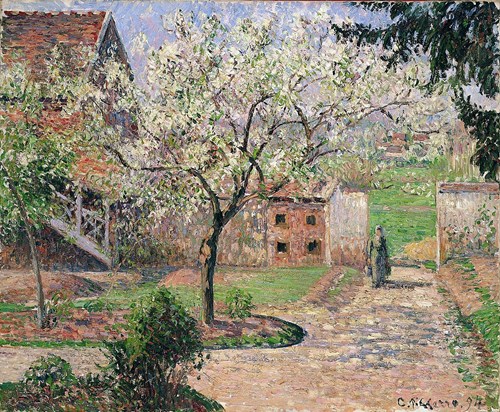Renewal and Rebirth: Symbolism of Spring in Art History

As we celebrate the arrival of spring each year, let us not only revel in its beauty but also reflect on the deeper meanings it holds for us as individuals and as a society. For in the blooming of flowers and the greening of landscapes, we find hope, inspiration, and the promise of new beginnings.
Here is some info on various springtime symbolism, throughout art history:
***** ANCIENT ROOTS *****
The roots of spring symbolism in art can be traced back to ancient civilizations such as the Egyptians, Greeks, and Romans, who worshipped deities associated with fertility, agriculture, and rebirth. In Egyptian mythology, the goddess Isis was revered as the giver of life and fertility, often depicted with symbols of spring such as flowers and young plants.
Similarly, in Greek mythology, the story of Persephone's return from the underworld marked the arrival of spring, symbolizing the cycle of death and rebirth. This theme was further explored in Roman art, where the goddess Flora was celebrated during the spring festival of Floralia, symbolizing the renewal of life and the blooming of flowers.
***** MEDIEVAL ALLEGORY *****
During the Middle Ages, Christian art incorporated the symbolism of spring into religious allegories, representing the resurrection of Christ and the promise of salvation. The motif of the "Tree of Life" adorned with blossoms and foliage became a popular symbol of spiritual renewal, embodying the idea of eternal life and redemption.
In illuminated manuscripts and church frescoes, scenes of lush gardens and flourishing landscapes were used to evoke the paradisiacal beauty of the Garden of Eden, reinforcing the notion of spring as a time of spiritual awakening and divine grace.
***** RENAISSANCE REVIVAL *****
The Renaissance saw a revival of interest in classical mythology and the natural world, leading to a renewed fascination with the symbolism of spring in art. Artists such as Botticelli captured the essence of spring in their works, depicting scenes of mythological figures amidst blooming flowers and verdant landscapes.
Botticelli's iconic painting "Primavera" (Spring) is a prime example of this, portraying a lush garden scene populated by gods and goddesses, symbolizing the rejuvenating power of nature and the eternal cycle of life.
***** MODERN INTERPRETATIONS *****
In modern art, the symbolism of spring continues to inspire artists, albeit in new and innovative ways. From the vibrant floral still lifes of Impressionist painters like Claude Monet to the abstract expressions of contemporary artists exploring themes of growth and regeneration, the imagery of spring remains a timeless source of inspiration.
Contemporary artists often use spring symbolism as a metaphor for personal transformation and collective renewal, addressing pressing issues such as environmental sustainability, social justice, and the resilience of the human spirit in the face of adversity.
Here are some lovely Spring-inspired paintings to enjoy:
Primavera, c.1478 by Sandro Botticelli
Botticelli’s famous painting celebrates the arrival of spring and is filled with mythological symbolism. It was one of the first large-scale European paintings to tell a story that was not Christian, replacing the agony of Easter with a pagan rite. Remarkably botanists have identified 200 accurately depicted plants. It’s a poetic scene that transcends reality as the figures seem to float above the grass.
https://abou...is-primavera/
Springtime, 1886 by Claude Monet
This is one of two paintings of Monet’s orchard at Giverny and depicts his favourite model, Suzanne Hosched with her son, Jean. As Virginia Spade has observed, this scene is ‘a recreation of the sensation of being submerged in blossom and new leaves, in the scent and warmth of a spring day in which everything is vibrantly alive’.
https://fren...ringtime-1886
Almond Blossom, 1890 by Vincent van Gogh
Large blossom branches like this against a blue sky were one of Van Gogh’s favourite subjects which he borrowed from Japanese printmaking and are symbolic of new life.
The painting was a gift for his brother Theo and sister-in-law Jo, who had just had a baby son, Vincent Willem. In the letter announcing the new arrival, Theo wrote: “As we told you, we’ll name him after you, and I’m making the wish that he may be as determined and as courageous as you.”
Unsurprisingly, it was this work that remained closest to the hearts of the Van Gogh family.
https://www....on/s0176v1962
Spring Bouquet (1866) by Pierre-Auguste Renoir
Despite its seeming looseness, this famous spring art painting has a strict structure. With an asymmetry as wild and free as nature itself, the flowers burst over into the lower left-hand corner in joyful abundance. However, the artist immediately begins to correct this imbalance. Renoir has created a deep shadow region to the right of the container, rich in purple tones, shaggy in form, and starkly contrasting with the area of light below it. The placement of the ruler-straight lines in the lower right corner of the painting is especially important. When Renoir created this painting, the Impressionist approach had not yet matured.
The brushwork is strong, and the color is thick and rich, evoking Gustave Courbet. And, instead of a generalized appearance of dazzling color, which would later imply rather than represent flowers, the petals are individual and distinct here.
https://harv...object/303729
Plum Trees in Blossom Éragny (1894) by Camille Pissarro
(**This is the painting you see in the image, above)
Pissarro focused on his immediate environment. He was drawn to depicting ordinary life in the family’s home, the hamlet, or the fields. His works of art are usually scenic, in a style influenced by Millet and Corot. Pissarro and his family relocated to Éragny, northwest of Paris, in 1884. This scene is from the house’s garden and depicts it in a dazzling spring light.
The focus is on the movement of light in the blossoming fruit trees, and Pissarro has completely embraced Impressionistic techniques.
https://muse...?pUnitId=5373
Share MORE famous spring artwork! | Come Make Your Own Spring Art!

